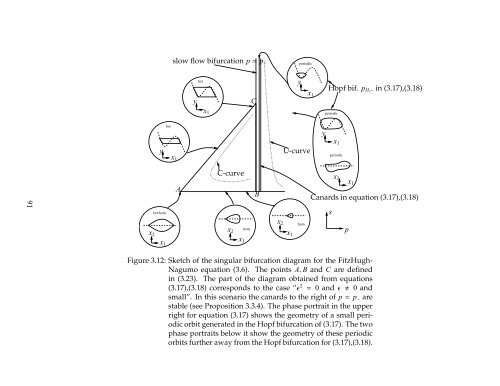multiple time scale dynamics with two fast variables and one slow ...
multiple time scale dynamics with two fast variables and one slow ...
multiple time scale dynamics with two fast variables and one slow ...
You also want an ePaper? Increase the reach of your titles
YUMPU automatically turns print PDFs into web optimized ePapers that Google loves.
91<br />
x2<br />
y<br />
het/hom<br />
x1<br />
het<br />
<strong>slow</strong> flow bifurcation p= p−<br />
x1<br />
A<br />
y<br />
het<br />
x1<br />
C-curve<br />
x2<br />
x1<br />
hom<br />
C<br />
B<br />
x2<br />
x1<br />
periodic<br />
y<br />
U-curve<br />
hom<br />
x1<br />
y<br />
Hopf bif. pH,− in (3.17),(3.18)<br />
periodic<br />
x1<br />
periodic<br />
s<br />
x2<br />
p<br />
x1<br />
Canards in equation (3.17),(3.18)<br />
Figure 3.12: Sketch of the singular bifurcation diagram for the FitzHugh-<br />
Nagumo equation (3.6). The points A, B <strong>and</strong> C are defined<br />
in (3.23). The part of the diagram obtained from equations<br />
(3.17),(3.18) corresponds to the case “ǫ 2 = 0 <strong>and</strong>ǫ 0 <strong>and</strong><br />
small”. In this scenario the canards to the right of p= p− are<br />
stable (see Proposition 3.3.4). The phase portrait in the upper<br />
right for equation (3.17) shows the geometry of a small periodic<br />
orbit generated in the Hopf bifurcation of (3.17). The <strong>two</strong><br />
phase portraits below it show the geometry of these periodic<br />
orbits further away from the Hopf bifurcation for (3.17),(3.18).
















